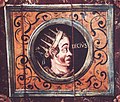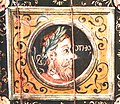Kaiser blanket
The Kaiserdecke is a 17th century ceiling painting from Lübeck .
backgrounds
The imperial ceiling, painted in 1623, is located in the audience house , an extension of the Lübschen Vogtei in Lübeck-Travemünde built in 1599 . Presumably in the 18th or 19th century it was hidden from view by a newly inserted false ceiling and completely forgotten. Since their existence was not documented in written sources either, nobody knew that the late Renaissance work of art existed in the building that was last used as a police station.
In 2005 the Hanseatic City of Lübeck sold the Bailiwick to a private citizen who had restoration work carried out. When the false ceiling was removed in January 2006, the almost intact ceiling paintings were rediscovered.
Design and interpretation
The wooden ceiling is divided into four rows of three fields each; by Illusionsmalerei the appearance of a is coffered ceiling awakened. Surrounded by Mauresques , each field contains a round medallion with a profile portrait of a Roman emperor or general looking to the right . Only the middle field of the top row shows the Lübeck coat of arms and the year of creation of the work of art, 1623, instead of a portrait . The signature of the artist Hans Reincke , otherwise known for no other works, can be found together with the year in an inconspicuous place on the ceiling.
The persons depicted are identified by names, some of which are abbreviated, in Capitalis monumentalis and, according to ancient custom, wear imperial tiaras , Hellenistic radiant crowns or laurel wreaths . The representations make it seem conceivable that Reincke designed them from contemporary engravings from ancient coin portraits, but this has not yet been proven. The arrangement of the ceiling elements is as follows:
| Mark Antony | Lübeck coat of arms | Hostilian |
| Trebonianus Gallus | Tiberius | Augustus |
| Decius | Pescennius Niger | Vitellius |
| Otho | Justin I. | Nerva |
It is unclear which statement should be made with this ceiling painting. The rulers depicted are not depicted in any comprehensible chronology and their composition does not correspond to any known, fixed canon of portraits or common iconography . In addition to historically outstanding figures, there are also usurpers , counter-emperors and secondary rulers with, in some cases, extremely short periods of rule. In addition, their characters are so different that no exemplary function of any kind can be derived from the people.
Rolf Gramatzki assumed that the emperors depicted do not stand for themselves, but rather are symbolically equated through their respective historical roles with people who were important for the history of Lübeck. The ceiling painting would therefore be an encoded history of Lübeck that would only have been understandable to those with a corresponding history.
Regardless of its original content, the Kaiserdecke is an important work of art. No other 17th century ceiling paintings in such good condition are known in Schleswig-Holstein .
Single portraits
literature
- Antjekathrin Graßmann (ed.): Journal for Lübeckische Geschichte , Volume 90. Verlag Schmidt-Römhild , 2010. ISBN 978-3-7950-1489-6
- Vivien Somma: The "Kaiserdecke" in the old bailiwick in Travemünde . Lübeckische Blätter 5, March 8, 2008, pp. 81-89
Web links
- Article about finding the Kaiserdecke , Lübecker Stadtzeitung, April 11, 2006
Coordinates: 53 ° 57 '23.3 " N , 10 ° 51' 58.2" E



